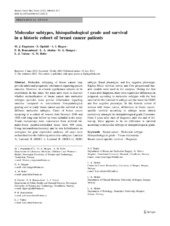| dc.contributor.author | Engstrøm, Monica J | en_US |
| dc.contributor.author | Opdahl, Signe | en_US |
| dc.contributor.author | Hagen, Anne Irene | en_US |
| dc.contributor.author | Romundstad, Pål Richard | en_US |
| dc.contributor.author | Akslen, Lars A. | en_US |
| dc.contributor.author | Haugen, Olav A. | en_US |
| dc.contributor.author | Vatten, Lars Johan | en_US |
| dc.contributor.author | Bofin, Anna M. | en_US |
| dc.date.accessioned | 2015-10-16T07:25:56Z | |
| dc.date.available | 2015-10-16T07:25:56Z | |
| dc.date.issued | 2013-08 | |
| dc.Published | Breast Cancer Research and Treatment 2013, 140(3):463-473 | eng |
| dc.identifier.issn | 0167-6806 | |
| dc.identifier.uri | https://hdl.handle.net/1956/10573 | |
| dc.description.abstract | Molecular subtyping of breast cancer may provide additional prognostic information regarding patient outcome. However, its clinical significance remains to be established. In this study, the main aims were to discover whether reclassification of breast cancer into molecular subtypes provides more precise information regarding outcome compared to conventional histopathological grading and to study breast cancer-specific survival in the different molecular subtypes. Cases of breast cancer occurring in a cohort of women born between 1886 and 1928 with long-term follow-up were included in the study. Tissue microarrays were constructed from archival formalin-fixed, paraffin-embedded tissue from 909 cases. Using immunohistochemistry and in situ hybridisation as surrogates for gene expression analyses, all cases were reclassified into the following molecular subtypes: Luminal A; Luminal B (HER2−); Luminal B (HER2+); HER2 subtype; Basal phenotype; and five negative phenotype. Kaplan–Meier survival curves and Cox proportional hazards models were used in the analyses. During the first 5 years after diagnosis, there were significant differences in prognosis according to molecular subtypes with the best survival for the Luminal A subtype and the worst for HER2 and five negative phenotype. In this historic cohort of women with breast cancer, differences in breast cancer-specific survival according to subtype occur almost exclusively amongst the histopathological grade 2 tumours. From 5 years after time of diagnosis until the end of follow-up, there appears to be no difference in survival according to molecular subtype or histopathological grade. | en_US |
| dc.language.iso | eng | eng |
| dc.publisher | Springer | eng |
| dc.rights | Attribution CC BY-NC | eng |
| dc.rights.uri | http://creativecommons.org/licenses/by-nc/3.0/ | eng |
| dc.title | Molecular subtypes, histopathological grade and survival in a historic cohort of breast cancer patients | en_US |
| dc.type | Peer reviewed | |
| dc.type | Journal article | |
| dc.date.updated | 2015-08-27T10:19:44Z | |
| dc.description.version | publishedVersion | en_US |
| dc.rights.holder | Copyright 2013 The Authors | |
| dc.identifier.doi | https://doi.org/10.1007/s10549-013-2647-2 | |
| dc.identifier.cristin | 1044267 | |
| dc.relation.project | Norges forskningsråd: 191778 | |
| dc.relation.project | Norges forskningsråd: 223250 | |

